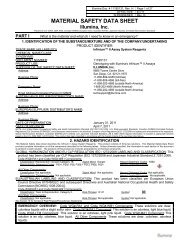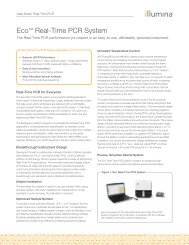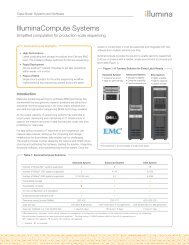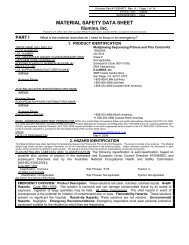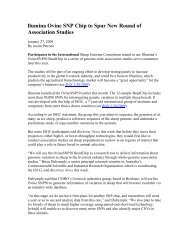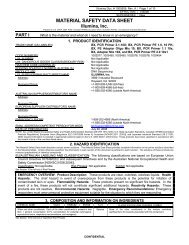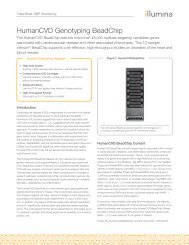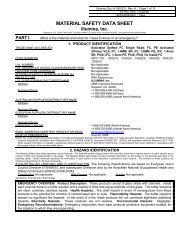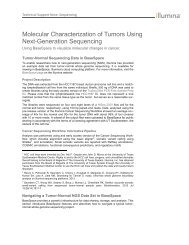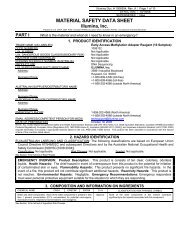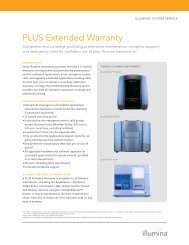MATERIAL SAFETY DATA SHEET - Illumina
MATERIAL SAFETY DATA SHEET - Illumina
MATERIAL SAFETY DATA SHEET - Illumina
You also want an ePaper? Increase the reach of your titles
YUMPU automatically turns print PDFs into web optimized ePapers that Google loves.
TruSeq Enrichment Kit <strong>Illumina</strong> Doc. #15018476, Rev. A Page 9 of 17<br />
11. TOXICOLOGICAL INFORMATION (Continued)<br />
TOXICITY <strong>DATA</strong> (continued):<br />
CHLORIDE SALT (continued):<br />
LDLo (Oral-Infant) 938 mg/kg/2 days: Lungs, Thorax,<br />
or Respiration: cyanosis, other changes; Nutritional<br />
and Gross Metabolic: changes in potassium<br />
LDLo (Oral-Man) 20 mg/kg: Cardiac: arrhythmias<br />
(including changes in conduction); Gastrointestinal:<br />
nausea or vomiting; Blood: change in clotting factors<br />
TDLo (Oral-Man) 60 mg/kg/ days: Gastrointestinal:<br />
nausea or vomiting; Blood: change in clotting factors<br />
Standard Draize Test (Eye-Rabbit) 500 mg/24 hours:<br />
Mild<br />
LD50 (Oral-Rat) 2600 mg/kg<br />
LD50 (Oral-Mouse) 1500 mg/kg<br />
LD50 (Intraperitoneal-Rat) 660 mg/kg<br />
LD50 (Intraperitoneal-Mouse) 620 mg/kg<br />
LD50 (Intravenous-Rat) 142 mg/kg<br />
LD50 (Intravenous-Rat) 142 mg/kg: Behavioral:<br />
convulsions or effect on seizure threshold; Lungs,<br />
Thorax, or Respiration: dyspnea<br />
LD50 (Intravenous-Mouse) 117 mg/kg<br />
LDLo (Oral-Guinea Pig) 2500 mg/kg: Behavioral:<br />
changes in motor activity (specific assay), coma;<br />
Lungs, Thorax, or Respiration: other changes<br />
LDLo (Intraperitoneal-Guinea Pig) 900 mg/kg:<br />
Behavioral: changes in motor activity (specific<br />
assay), coma Lungs, Thorax, or Respiration: other<br />
changes<br />
LDLo (Subcutaneous-Guinea Pig) 2550 mg/kg<br />
LDLo (Subcutaneous-Pigeon) 2210 mg/kg<br />
LDLo (Subcutaneous-Frog) 2120 mg/kg<br />
LDLo (Intravenous-Guinea Pig) 77 mg/kg<br />
LDLo (Parenteral-Guinea Pig) 40 mg/kg<br />
LDLo (Intraarterial-Guinea Pig) 130 mg/kg<br />
TDLo (Oral-Rat) 75.6 gm/kg/6 weeks-continuous:<br />
Kidney/Ureter/Bladder: urine volume increased<br />
TDLo (Oral-Rat) 983 gm/kg/78 weeks-continuous:<br />
Kidney/Ureter/Bladder: changes in tubules<br />
(including acute renal failure, acute tubular necrosis)<br />
TDLo (Oral-Rat) 1536 gm/kg/130 weeks-continuous:<br />
Endocrine: adrenal cortex hyperplasia<br />
TDLo (Intracerebral-Rat) 272.7 mg/kg: Biochemical:<br />
Neurotransmitters or modulators (putative):<br />
dopamine in striatum<br />
DNA Damage (Human-Leukocyte) 1 mmol/L/2 hours<br />
Mutation in Microorganisms (Bacteria-Salmonella<br />
typhimurium) 100 µg/plate<br />
Mutation in Microorganisms (Yeast-Saccharomyces<br />
cerevisiae) 2500 mmol/L<br />
CHLORIDE SALT (continued):<br />
Mutation in Microorganisms (Mouse-Lymphocyte)<br />
2048 mg/L<br />
Gene Conversion and Mitotic Recombination (Yeast-<br />
Saccharomyces cerevisiae) 400 mmol/L<br />
Sex Chromosome Loss and Non-Disjunction (Yeast-<br />
Saccharomyces cerevisiae) 300 mmol/L<br />
Unscheduled DNA Synthesis (Oral-Rat) 1500 µg/kg<br />
Cytogenetic Analysis (Hamster-Lung) 12 gm/L<br />
Cytogenetic Analysis (Hamster-Ovary) 140 mmol/L<br />
DNA Damage (Hamster-Ovary) 260 mmol/L<br />
Sister Chromatid Exchange (Hamster-Ovary) 180<br />
mmol/L<br />
POTASSIUM PHOSPHATE, MONOBASIC:<br />
LDLo (oral, rat) = 4640 mg/kg: Behavioral: somnolence<br />
(general depressed activity); Gastrointestinal: other<br />
changes<br />
LD50 (skin, rabbit) > 4640 mg/kg<br />
SODIUM SALT:<br />
TDLo (oral, human) = 12,357 mg/kg/23<br />
days/continuous; Cardiovascular effects<br />
TDLo (intraplacental, woman) = 27 mg/kg/15 weeks<br />
pregnant; Reproductive effects<br />
Skin Irritancy (rabbit) = 50 mg/24 hours; mild<br />
Skin Irritancy (rabbit) = 500 mg/24 hours; mild<br />
Eye Irritancy (rabbit) = 100 mg; mild<br />
Eye Irritancy (rabbit) = 100 mg/24 hours; moderate<br />
Eye Irritancy (rabbit) = 10 mg; moderate<br />
LC50 (inhalation, rat) > 42 g/m 3 /1 hour<br />
LD50 (oral, rat) = 3000 mg/kg<br />
LD50 (oral, mouse) = 4000 mg/kg<br />
LD50 (skin, rabbit) > 10 g/kg<br />
LD50 (intraperitoneal, mouse) = 6614 mg/kg<br />
LD50 (subcutaneous, mouse) = 3 g/kg<br />
LD50 (intravenous, mouse) = 645 mg/kg<br />
LD50 (intracervical, mouse) = 131 mg/kg<br />
TDLo (oral, rat) = 145 g/kg/female 7 days premating/female<br />
1–22 days after conception;<br />
Reproductive: Delayed Effects on Newborn<br />
TDLo (oral, rat) = 56400 mg/kg/female 5 days premating/21<br />
days post-birth; Reproductive: Maternal<br />
Effects: postpartum, Effects on Newborn:<br />
biochemical and metabolic<br />
TDLo (oral, rat) = 16800 mg/kg/28 days/continuous;<br />
Endocrine: changes in adrenal weight<br />
TDLo (intrauterine, rat) = 500 mg/kg/female 4 days<br />
after conception; Reproductive: Fertility: preimplantation<br />
mortality (e.g., reduction in number of<br />
implants per female; total number of implants per<br />
corpora lutea)<br />
SODIUM SALT (continued):<br />
TDLo (parenteral, rat) = 10 mg/kg/female 1 day premating;<br />
Reproductive: Maternal Effects: ovaries,<br />
fallopian tubes<br />
TDLo (subcutaneous, mouse) = 2500 mg/kg/female 10<br />
days after conception; Reproductive: Effects on<br />
Fetus: fetotoxicity (except death, e.g., stunted fetus)<br />
TDLo (subcutaneous, mouse) = 1900 mg/kg/female<br />
10–11 days after conception; Reproductive: Effects<br />
on Fetus: fetal death, Specific Developmental<br />
Abnormalities: musculoskeletal system<br />
TDLo (intraperitoneal, rat) = 1710 mg/kg/female<br />
13days post; Teratogenic effects<br />
LDLo (oral, rabbit) = 8 g/kg<br />
LDLo (subcutaneous, rat) = 3500 mg/kg<br />
LDLo (subcutaneous, guinea pig) = 2160 mg/kg<br />
LDLo (intraperitoneal, dog) = 364 mg/kg<br />
LDLo (intravenous, dog) = 2 g/kg<br />
LDLo (intravenous, rabbit) = 1100 mg/kg<br />
LDLo (intravenous, guinea pig) = 2910 mg/kg<br />
LDLo (parenteral, guinea pig) = 300 mg/kg<br />
LDLo (intraarterial, guinea pig) = 300 mg/kg<br />
Mutation in Microorganisms (yeast, Saccharomyces<br />
cerevisiae) = 2 mol/L<br />
DNA Inhibition (fibroblast, human) = 125 mmol/L<br />
Unscheduled DNA Synthesis (oral, rat) = 16800<br />
mg/kg/4 weeks/continuous<br />
Cytogenetic Analysis (intraperitoneal, rat) = 2338<br />
mg/kg<br />
Cytogenetic Analysis (ovary, hamster) = 160 mmol/L<br />
Cytogenetic Analysis (lung, hamster) = 7500 mg/L<br />
DNA Damage (lymphocyte, mouse) = 101 mmol/L<br />
DNA Damage (ovary, hamster) = 275 mmol/L<br />
Mutation in Mammalian Somatic Cells (lymphocyte,<br />
mouse) = 57200 µmol/L<br />
Micronucleus Test (lung, hamster) = 4 g/L<br />
ALKALI HYDROXIDE:<br />
LD50 (intraperitoneal, mouse) = 40 mg/kg<br />
LDLo (oral, rabbit) = 500 mg/kg<br />
Eye Irritancy (monkey) = 1%/24 hours; severe<br />
Skin Irritancy (rabbit) = 500 mg/24 hours; severe<br />
Eye Irritancy (rabbit) = 400 µg; mild<br />
Eye Irritancy (rabbit) = 1%; severe<br />
Eye Irritancy (rabbit) = 50 μg/24 hours; severe<br />
Eye Irritancy (rabbit) = 1 mg/24 hours; severe<br />
Eye Irritancy (rabbit) = 1 mg/30 sec/rinsed; severe<br />
Cytogenetic Analysis (parenteral, grasshopper) = 20 mg<br />
Cytogenetic Analysis (lung, hamster) = 10 mmol/L<br />
Cytogenetic Analysis (hamster) = 16 mmol/L<br />
CARCINOGENIC POTENTIAL OF COMPONENTS: The constituents in the solutions of this product are not found<br />
on the following lists: U.S. EPA, U.S. NTP, U.S. OSHA, U.S. NIOSH, GERMAN MAK, IARC, or ACGIH and<br />
therefore are neither considered to be nor suspected to be cancer causing agents by these agencies.<br />
IRRITANCY OF PRODUCT:<br />
GA#-HP3: This component can severely irritate and burn contaminated tissue.<br />
TC#-CT1, TC#-SMB, and TC#-WS1: Depending on the duration and concentration of overexposure, skin and eye contact can<br />
irritate contaminated tissue.<br />
All Other Solutions: Contact with the skin or eyes may cause mild irritation, which is alleviated upon rinsing.<br />
SENSITIZATION TO THE PRODUCT: These solutions are not known to cause skin or respiratory sensitization.<br />
REPRODUCTIVE TOXICITY INFORMATION: Listed below is information concerning the effects of this product and<br />
its components on the human reproductive system.<br />
Mutagenicity: The constituents in the solutions in this product are not reported to produce mutagenic effects in humans. Animal<br />
mutation data are available for the Aliphatic Amide constituent in this product’s solutions; these data were obtained during<br />
clinical studies on specific animal tissues exposed to high doses of this compound.<br />
Embryotoxicity: The constituents in the solutions in this product are not reported to cause human embryotoxic effects.<br />
Teratogenicity: The constituents in the solutions in this product are reported to cause teratogenic effects in humans. Clinical<br />
studies on test animals exposed to relatively high doses of the Aliphatic Amide constituent in this product’s solutions, indicate<br />
teratogenic effects.<br />
Reproductive Toxicity: The constituents in the solutions in this product are not reported to cause adverse reproductive effects in<br />
humans. Clinical studies on test animals exposed to relatively high doses of the Aliphatic Amide constituent in this product’s<br />
solutions indicate adverse reproductive effects.<br />
A mutagen is a chemical that causes permanent changes to genetic material (DNA) such that the changes will propagate through<br />
generation lines. An embryotoxin is a chemical that causes damage to a developing embryo (i.e., within the first eight weeks of<br />
pregnancy in humans), but the damage does not propagate across generational lines. A teratogen is a chemical that causes<br />
damage to a developing fetus, but the damage does not propagate across generational lines. A reproductive toxin is any<br />
substance that interferes in any way with the reproductive process.<br />
BIOLOGICAL EXPOSURE INDICES: Currently, there are no Biological Exposure Indices (BEIs) determined for the<br />
constituents in this product’s solutions.



